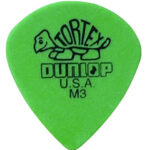For die-hard AC/DC fans and guitar aficionados, the gear used by Angus and Malcolm Young is almost as legendary as their riffs. Website acdc.com, managed by the knowledgeable Bill “Bonfire,” published an article detailing the iconic guitars of these rock titans. While insightful, it touched upon a common belief regarding Angus Young’s first Gibson SG, suggesting it might have been a 1968 model. But what if that widely accepted detail isn’t entirely accurate?
This article delves into the fascinating details surrounding Angus Young’s go-to instrument, the Guitar Sg, and presents evidence suggesting his first love affair with this iconic model might have begun with a slightly later vintage – a late 1970 or 1971 Gibson SG Standard, to be precise. Let’s explore the subtle clues that challenge the ’68 narrative and uncover the potential truth behind Angus’s original guitar SG.
Bonfire’s Insight: A Starting Point
Bonfire’s article on acdc.com provides a valuable overview of the Young brothers’ guitars. It correctly highlights Malcolm’s long-term relationship with his modified 1963 Gretsch Jet Firebird and Angus’s unwavering loyalty to the Gibson SG. The article mentions Angus’s preference for lightweight SG models and acknowledges his use of various SG Customs and Standards, including a favored early 1968 stock SG with lightning bolt inlays. However, it’s the assertion about Angus’s first SG potentially being a 1970 or 1971 model that warrants closer examination and possible correction to the common ’68 assumption.
Challenging the 1968 Myth: Visual and Textual Clues
The claim that Angus Young’s first Gibson SG was a 1968 model, often repeated by Gibson themselves in relation to signature models, might need a second look. Examining photographic and video evidence from Angus’s early years with AC/DC, along with details about Gibson’s production changes, paints a compelling picture that points towards a later year for his initial guitar SG.
The Walnut Finish Factor
One of the most immediate visual indicators is the color of the guitar SG Angus is seen playing in early photos. This guitar SG exhibits a distinctive walnut finish – a brownish hue – rather than the dark cherry red typically associated with 1968 Gibson SGs. Walnut finishes were introduced by Gibson in the late 1960s and became more prevalent in the 1970s. The presence of this walnut finish strongly suggests a production year later than 1968 for Angus’s first guitar SG.
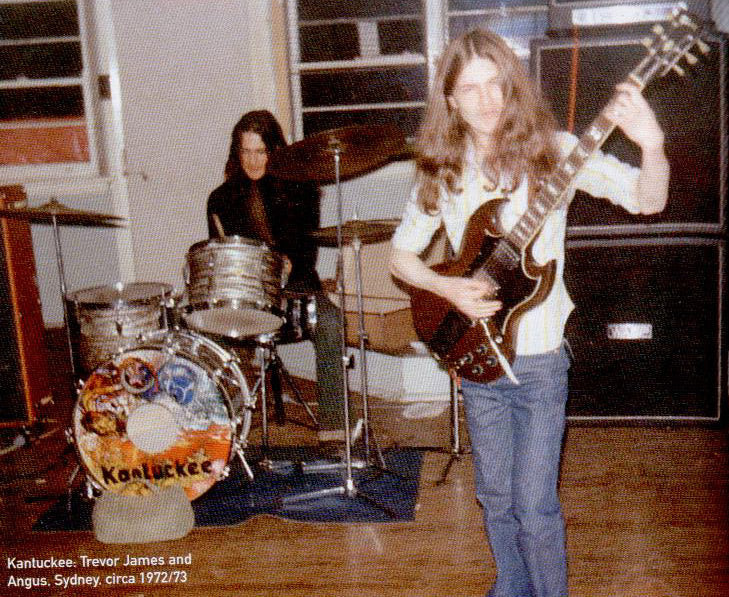 Young Angus Young with a walnut Gibson SG Standard, likely a 1970 or 1971 model, showcasing its walnut finish and shallow cutaways.
Young Angus Young with a walnut Gibson SG Standard, likely a 1970 or 1971 model, showcasing its walnut finish and shallow cutaways.
Cutaway Carving Depths
Another crucial detail lies in the depth of the guitar SG‘s body cutaways. Guitars from the late 1960s, including 1968 models, typically feature deeper, more pronounced cutaways. In contrast, guitar SGs produced in the late 1969, 1970s and onward, transitioned to shallower cutaways. Observing the cutaways of Angus’s early guitar SG reveals a shallower carving, further supporting the theory of a 1970 or 1971 production date.
To illustrate this difference, consider these comparative images:
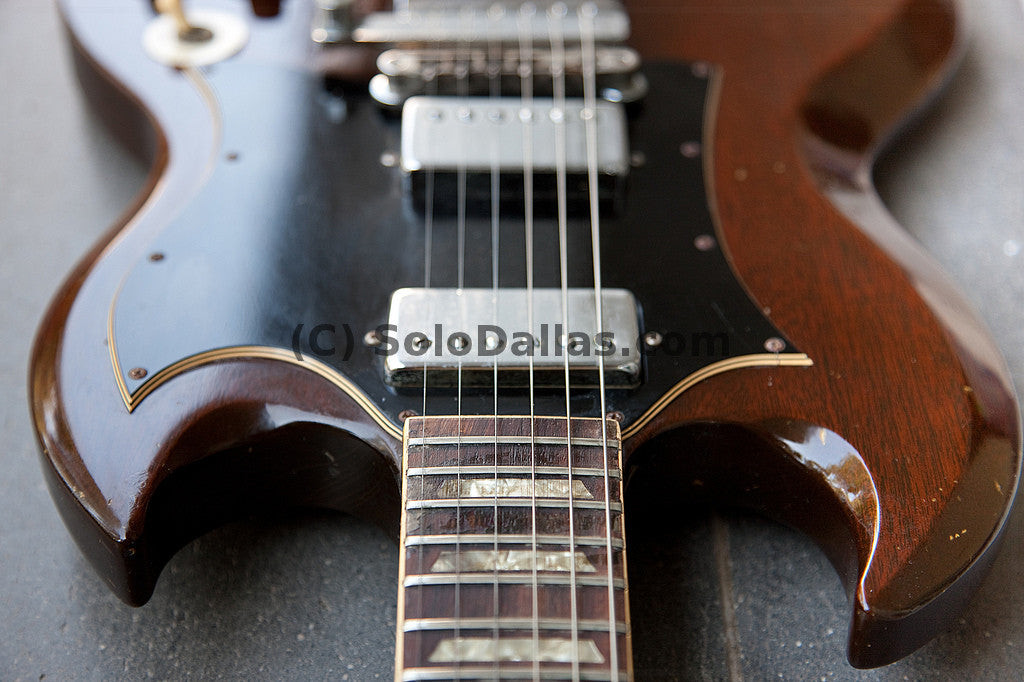 Comparison of Gibson SG cutaways: Top – 1970 SG Standard with shallow cutaways and walnut finish.
Comparison of Gibson SG cutaways: Top – 1970 SG Standard with shallow cutaways and walnut finish.
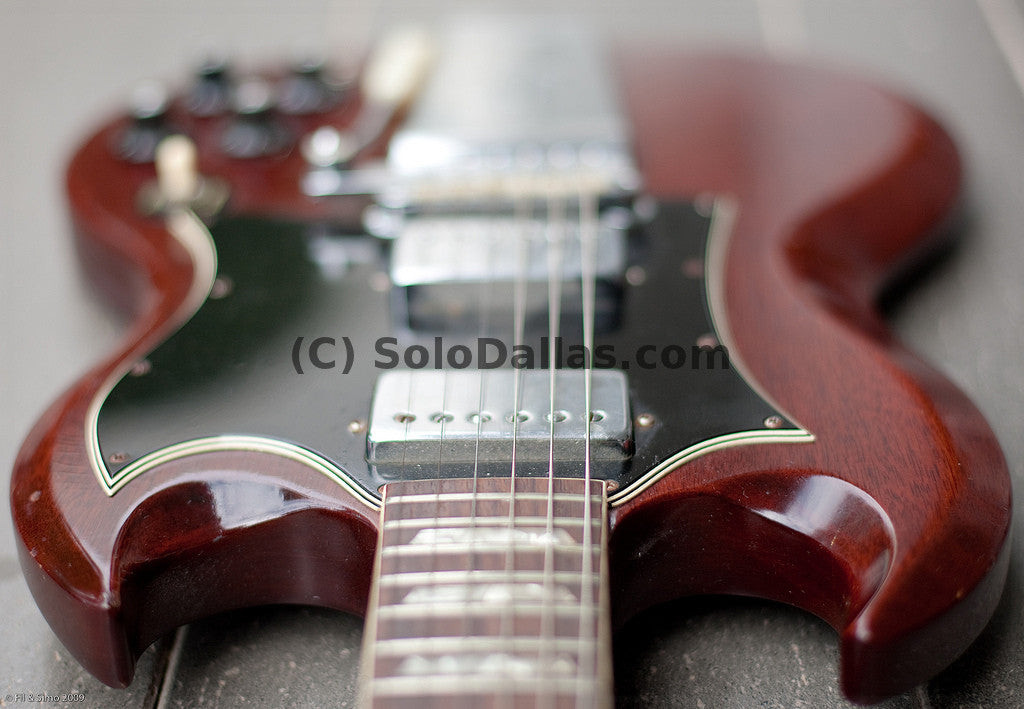 Comparison of Gibson SG cutaways: Bottom – 1969 SG Standard with deeper cutaways and dark cherry finish.
Comparison of Gibson SG cutaways: Bottom – 1969 SG Standard with deeper cutaways and dark cherry finish.
The top image, representing a 1970 SG Standard, clearly shows the shallower cutaways and walnut finish, mirroring the characteristics seen in photos of Angus’s early guitar SG. The bottom image, a 1969 model, demonstrates the deeper cutaways typical of earlier SGs.
The Volute and “Made in USA” Stamp
Further evidence emerges when examining the neck of Angus’s guitar SG in videos, such as the “Let There Be Rock” performance. Here, a volute – a small bulge at the neck-headstock joint – is visible. The volute was introduced by Gibson at the end of 1969 to strengthen the neck joint. Additionally, the presence of the “MADE IN USA” stamp, another feature introduced in late 1970, further reinforces the timeline pointing away from a 1968 origin for Angus’s initial guitar SG.
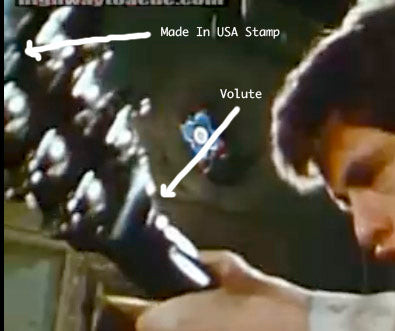 Angus Young playing a Gibson SG with a volute and "MADE IN USA" stamp in the "Let There Be Rock" video, indicative of a late 1969 or 1970s model.
Angus Young playing a Gibson SG with a volute and "MADE IN USA" stamp in the "Let There Be Rock" video, indicative of a late 1969 or 1970s model.
These details – the walnut finish, shallow cutaways, volute, and “MADE IN USA” stamp – collectively build a strong case for Angus Young’s first guitar SG being a late 1970 or 1971 model, rather than a 1968.
Angus Himself on Record
Adding further weight to this argument, an unearthed article features Angus Young himself stating the year of his first guitar SG. This direct confirmation from the guitar legend himself provides compelling textual evidence to support the visual observations.
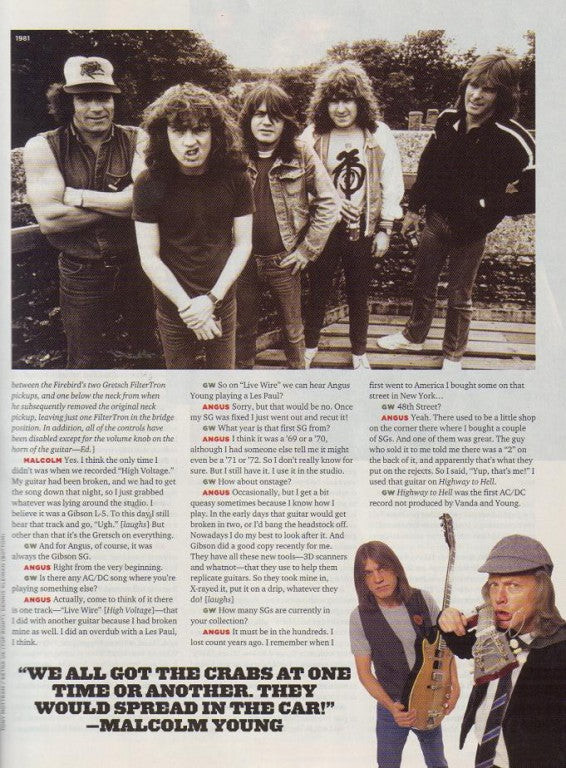 Article snippet quoting Angus Young stating the year of his first Gibson SG, supporting the theory that it was a later 1970 or 1971 model, not a 1968.
Article snippet quoting Angus Young stating the year of his first Gibson SG, supporting the theory that it was a later 1970 or 1971 model, not a 1968.
Interestingly, Gibson’s Angus Young Signature SG models, designed to replicate his iconic instrument, often feature shallow cutaways. This design choice subtly suggests that even Gibson might be acknowledging, or perhaps inadvertently replicating, features more characteristic of a later 1970s guitar SG in their signature series.
 Gibson Angus Young Signature SG model, featuring shallow cutaways, resembling Angus's likely first SG guitar from the early 1970s.
Gibson Angus Young Signature SG model, featuring shallow cutaways, resembling Angus's likely first SG guitar from the early 1970s.
Why This Matters to Gearheads
For most listeners, the subtle nuances of a guitar’s production year might seem insignificant. However, for dedicated guitarists, AC/DC fans, and gear enthusiasts, these details are part of the rich tapestry of rock history. Pinpointing the accurate year of Angus Young’s first guitar SG is about more than just trivia; it’s about understanding the evolution of an iconic instrument and appreciating the meticulous details that contribute to a legendary sound. It’s about getting closer to the authentic setup that powered some of the most electrifying riffs in rock and roll history.
Conclusion: Setting the Record Straight on the SG
While Bonfire’s article provides a great starting point for understanding Angus and Malcolm Young’s guitars, the evidence strongly suggests that the narrative around Angus’s first Gibson SG being a 1968 model might be inaccurate. Visual details like the walnut finish and shallow cutaways, combined with features like the volute and “MADE IN USA” stamp, and even Angus’s own words, point towards a late 1970 or 1971 Gibson SG Standard as his likely first guitar SG companion.
This exploration isn’t about diminishing the legacy of Gibson or AC/DC. Instead, it’s a testament to the enduring fascination with their gear and a quest for accuracy in the details that matter to passionate fans and guitar players worldwide. Let the debate continue, and may the riffs forever rock!

